automatic transmission fluid FORD TAURUS 2005 4.G Owners Manual
[x] Cancel search | Manufacturer: FORD, Model Year: 2005, Model line: TAURUS, Model: FORD TAURUS 2005 4.GPages: 248, PDF Size: 2.66 MB
Page 138 of 248
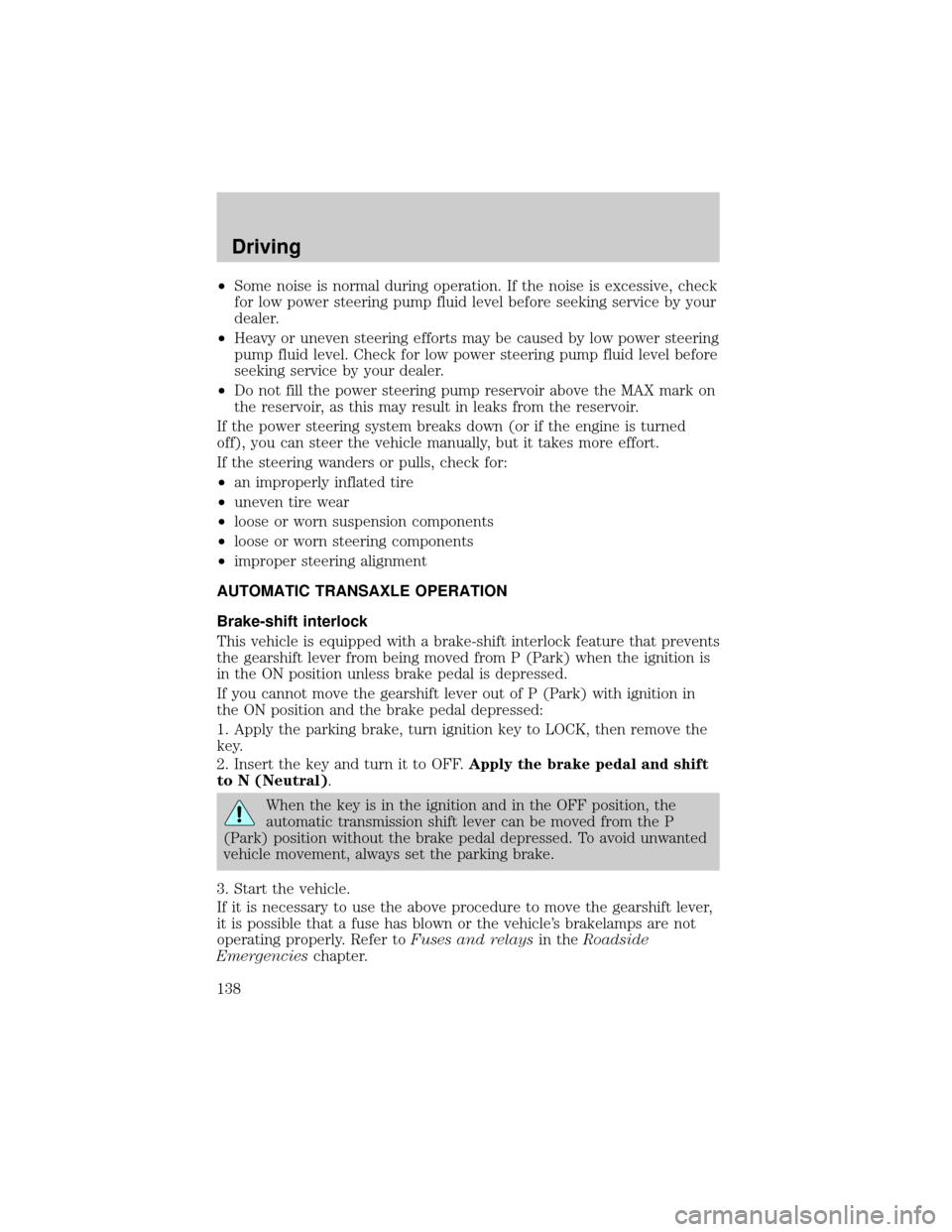
²Some noise is normal during operation. If the noise is excessive, check
for low power steering pump fluid level before seeking service by your
dealer.
²Heavy or uneven steering efforts may be caused by low power steering
pump fluid level. Check for low power steering pump fluid level before
seeking service by your dealer.
²Do not fill the power steering pump reservoir above the MAX mark on
the reservoir, as this may result in leaks from the reservoir.
If the power steering system breaks down (or if the engine is turned
off), you can steer the vehicle manually, but it takes more effort.
If the steering wanders or pulls, check for:
²an improperly inflated tire
²uneven tire wear
²loose or worn suspension components
²loose or worn steering components
²improper steering alignment
AUTOMATIC TRANSAXLE OPERATION
Brake-shift interlock
This vehicle is equipped with a brake-shift interlock feature that prevents
the gearshift lever from being moved from P (Park) when the ignition is
in the ON position unless brake pedal is depressed.
If you cannot move the gearshift lever out of P (Park) with ignition in
the ON position and the brake pedal depressed:
1. Apply the parking brake, turn ignition key to LOCK, then remove the
key.
2. Insert the key and turn it to OFF.Apply the brake pedal and shift
to N (Neutral).
When the key is in the ignition and in the OFF position, the
automatic transmission shift lever can be moved from the P
(Park) position without the brake pedal depressed. To avoid unwanted
vehicle movement, always set the parking brake.
3. Start the vehicle.
If it is necessary to use the above procedure to move the gearshift lever,
it is possible that a fuse has blown or the vehicle's brakelamps are not
operating properly. Refer toFuses and relaysin theRoadside
Emergencieschapter.
Driving
138
Page 189 of 248
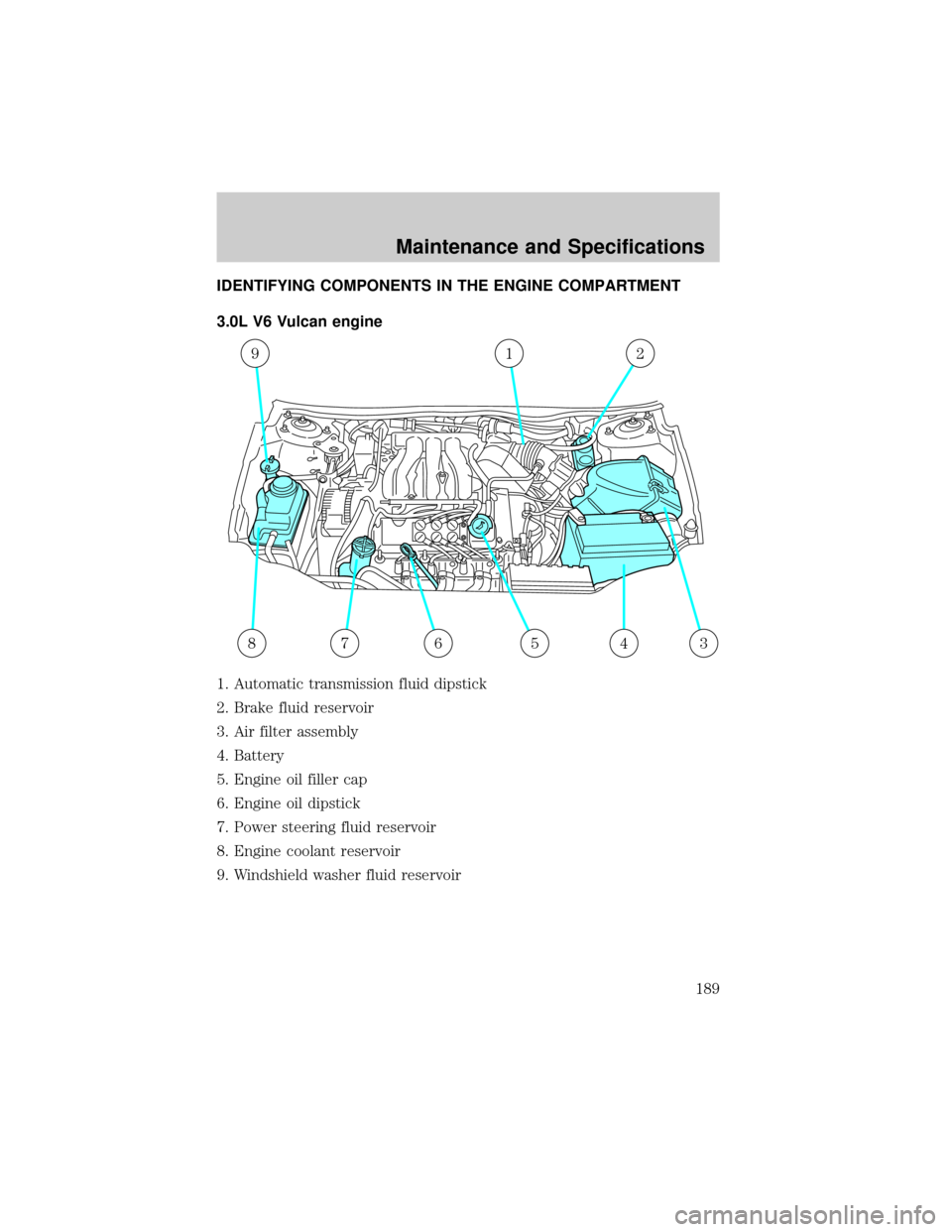
IDENTIFYING COMPONENTS IN THE ENGINE COMPARTMENT
3.0L V6 Vulcan engine
1. Automatic transmission fluid dipstick
2. Brake fluid reservoir
3. Air filter assembly
4. Battery
5. Engine oil filler cap
6. Engine oil dipstick
7. Power steering fluid reservoir
8. Engine coolant reservoir
9. Windshield washer fluid reservoir
786543
912
Maintenance and Specifications
189
Page 190 of 248
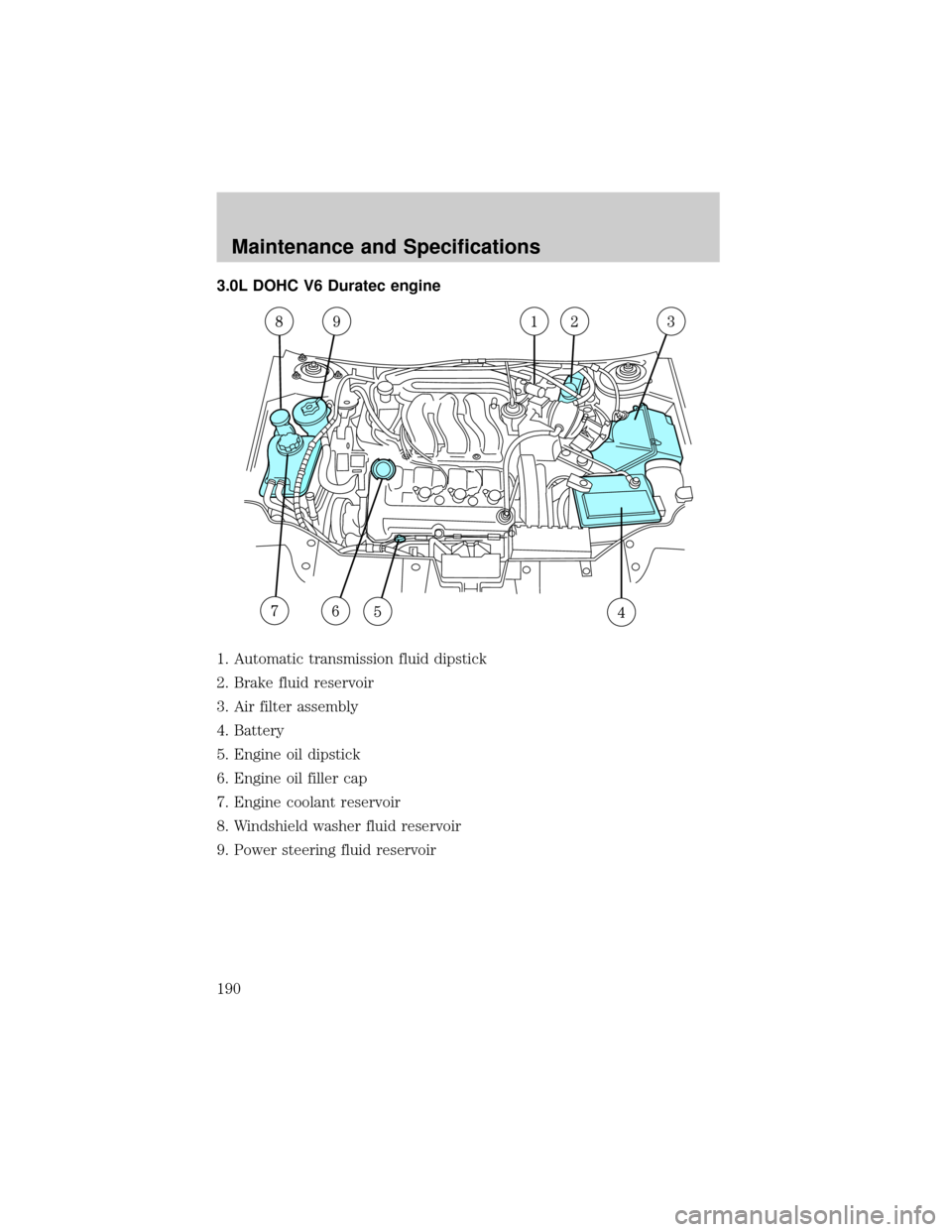
3.0L DOHC V6 Duratec engine
1. Automatic transmission fluid dipstick
2. Brake fluid reservoir
3. Air filter assembly
4. Battery
5. Engine oil dipstick
6. Engine oil filler cap
7. Engine coolant reservoir
8. Windshield washer fluid reservoir
9. Power steering fluid reservoir
Maintenance and Specifications
190
Page 216 of 248
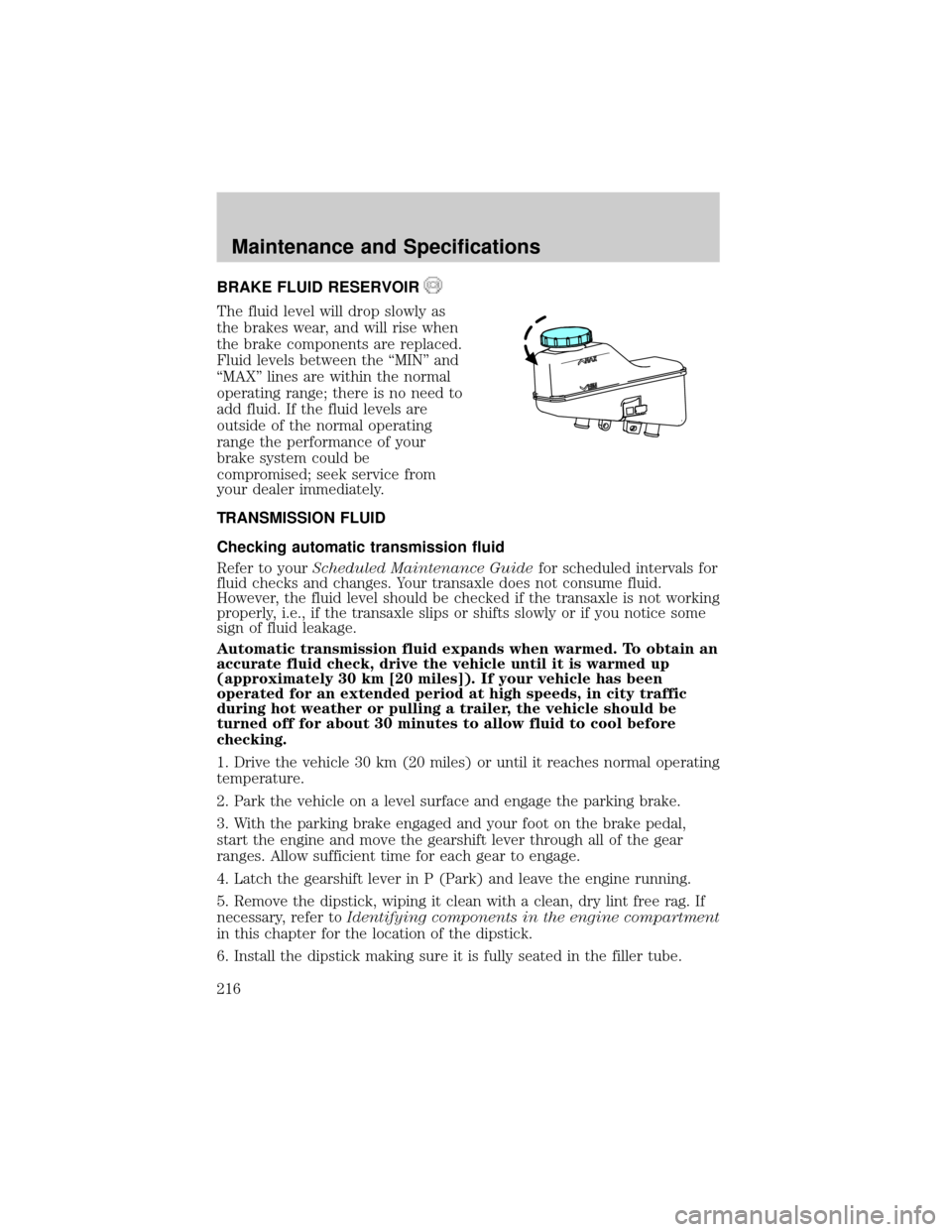
BRAKE FLUID RESERVOIR
The fluid level will drop slowly as
the brakes wear, and will rise when
the brake components are replaced.
Fluid levels between the ªMINº and
ªMAXº lines are within the normal
operating range; there is no need to
add fluid. If the fluid levels are
outside of the normal operating
range the performance of your
brake system could be
compromised; seek service from
your dealer immediately.
TRANSMISSION FLUID
Checking automatic transmission fluid
Refer to yourScheduled Maintenance Guidefor scheduled intervals for
fluid checks and changes. Your transaxle does not consume fluid.
However, the fluid level should be checked if the transaxle is not working
properly, i.e., if the transaxle slips or shifts slowly or if you notice some
sign of fluid leakage.
Automatic transmission fluid expands when warmed. To obtain an
accurate fluid check, drive the vehicle until it is warmed up
(approximately 30 km [20 miles]). If your vehicle has been
operated for an extended period at high speeds, in city traffic
during hot weather or pulling a trailer, the vehicle should be
turned off for about 30 minutes to allow fluid to cool before
checking.
1. Drive the vehicle 30 km (20 miles) or until it reaches normal operating
temperature.
2. Park the vehicle on a level surface and engage the parking brake.
3. With the parking brake engaged and your foot on the brake pedal,
start the engine and move the gearshift lever through all of the gear
ranges. Allow sufficient time for each gear to engage.
4. Latch the gearshift lever in P (Park) and leave the engine running.
5. Remove the dipstick, wiping it clean with a clean, dry lint free rag. If
necessary, refer toIdentifying components in the engine compartment
in this chapter for the location of the dipstick.
6. Install the dipstick making sure it is fully seated in the filler tube.
Maintenance and Specifications
216
Page 217 of 248
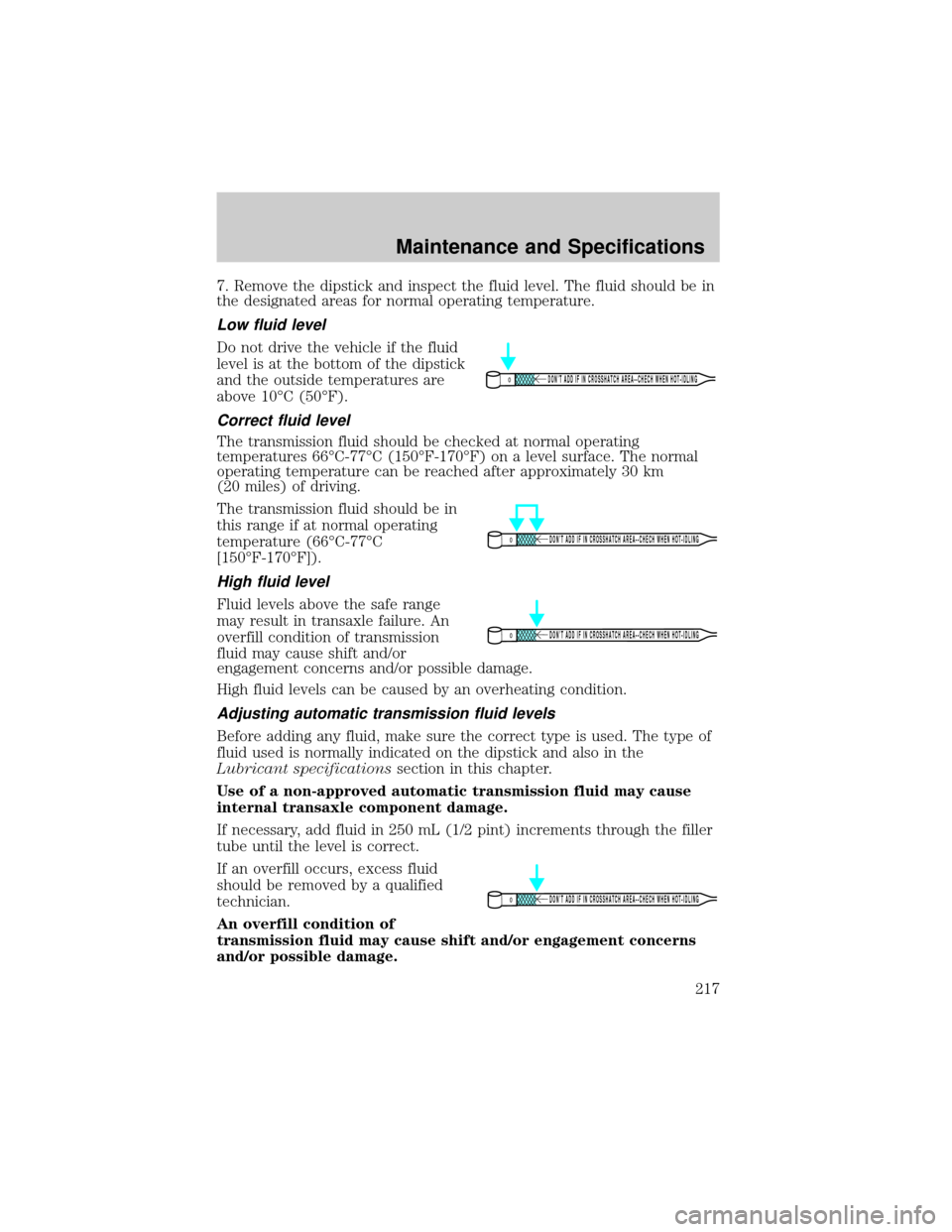
7. Remove the dipstick and inspect the fluid level. The fluid should be in
the designated areas for normal operating temperature.
Low fluid level
Do not drive the vehicle if the fluid
level is at the bottom of the dipstick
and the outside temperatures are
above 10ÉC (50ÉF).
Correct fluid level
The transmission fluid should be checked at normal operating
temperatures 66ÉC-77ÉC (150ÉF-170ÉF) on a level surface. The normal
operating temperature can be reached after approximately 30 km
(20 miles) of driving.
The transmission fluid should be in
this range if at normal operating
temperature (66ÉC-77ÉC
[150ÉF-170ÉF]).
High fluid level
Fluid levels above the safe range
may result in transaxle failure. An
overfill condition of transmission
fluid may cause shift and/or
engagement concerns and/or possible damage.
High fluid levels can be caused by an overheating condition.
Adjusting automatic transmission fluid levels
Before adding any fluid, make sure the correct type is used. The type of
fluid used is normally indicated on the dipstick and also in the
Lubricant specificationssection in this chapter.
Use of a non-approved automatic transmission fluid may cause
internal transaxle component damage.
If necessary, add fluid in 250 mL (1/2 pint) increments through the filler
tube until the level is correct.
If an overfill occurs, excess fluid
should be removed by a qualified
technician.
An overfill condition of
transmission fluid may cause shift and/or engagement concerns
and/or possible damage.
DON’T ADD IF IN CROSSHATCH AREA--CHECH WHEN HOT-IDLING
DON’T ADD IF IN CROSSHATCH AREA--CHECH WHEN HOT-IDLING
DON’T ADD IF IN CROSSHATCH AREA--CHECH WHEN HOT-IDLING
DON’T ADD IF IN CROSSHATCH AREA--CHECH WHEN HOT-IDLING
Maintenance and Specifications
217
Page 235 of 248
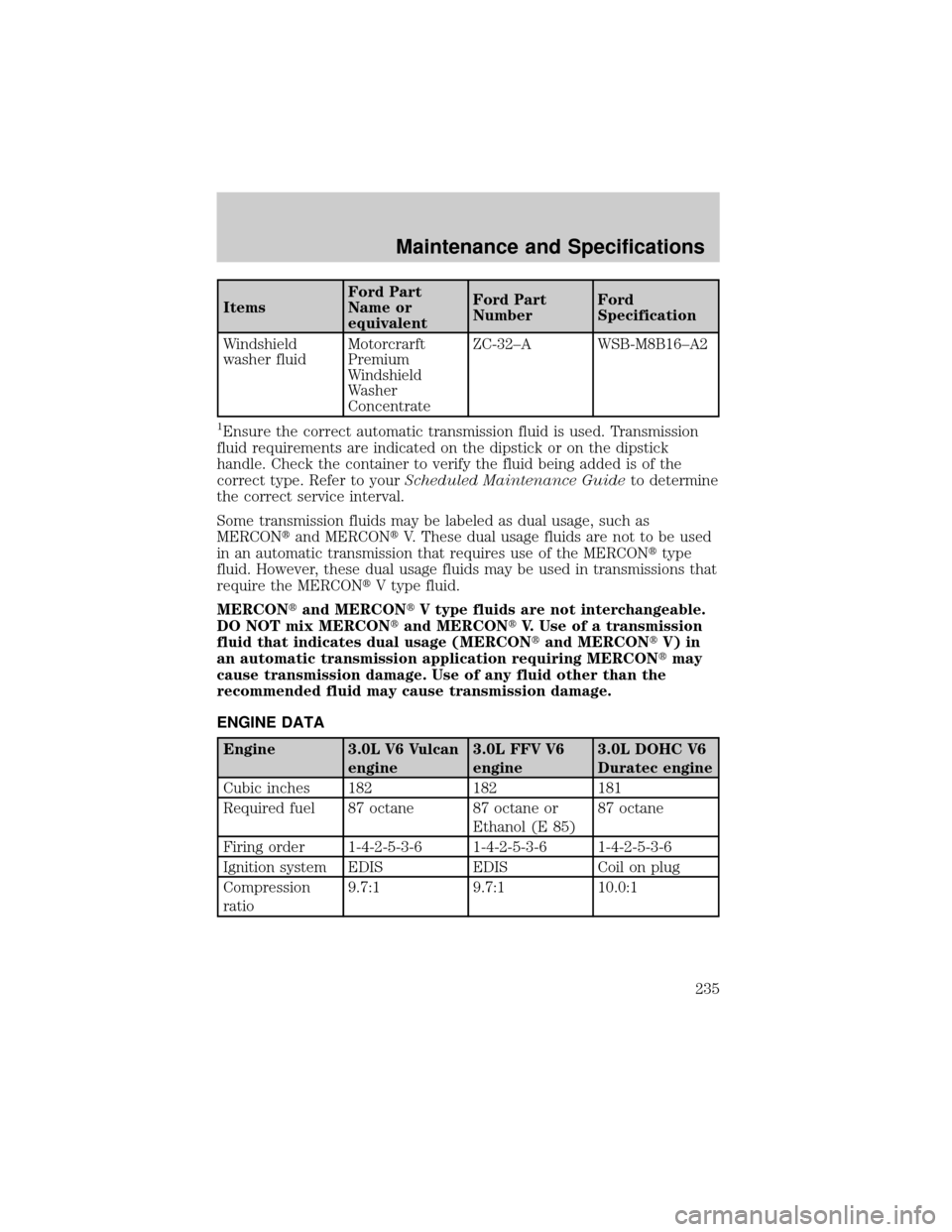
ItemsFord Part
Name or
equivalentFord Part
NumberFord
Specification
Windshield
washer fluidMotorcrarft
Premium
Windshield
Washer
ConcentrateZC-32±A WSB-M8B16±A2
1Ensure the correct automatic transmission fluid is used. Transmission
fluid requirements are indicated on the dipstick or on the dipstick
handle. Check the container to verify the fluid being added is of the
correct type. Refer to yourScheduled Maintenance Guideto determine
the correct service interval.
Some transmission fluids may be labeled as dual usage, such as
MERCONtand MERCONtV. These dual usage fluids are not to be used
in an automatic transmission that requires use of the MERCONttype
fluid. However, these dual usage fluids may be used in transmissions that
require the MERCONtV type fluid.
MERCONtand MERCONtV type fluids are not interchangeable.
DO NOT mix MERCONtand MERCONtV. Use of a transmission
fluid that indicates dual usage (MERCONtand MERCONtV) in
an automatic transmission application requiring MERCONtmay
cause transmission damage. Use of any fluid other than the
recommended fluid may cause transmission damage.
ENGINE DATA
Engine 3.0L V6 Vulcan
engine3.0L FFV V6
engine3.0L DOHC V6
Duratec engine
Cubic inches 182 182 181
Required fuel 87 octane 87 octane or
Ethanol (E 85)87 octane
Firing order 1-4-2-5-3-6 1-4-2-5-3-6 1-4-2-5-3-6
Ignition system EDIS EDIS Coil on plug
Compression
ratio9.7:1 9.7:1 10.0:1
Maintenance and Specifications
235
Page 243 of 248

A
Accessory delay ..........................49
Air bag supplemental restraint
system ........................108±109, 115
and child safety seats ............111
description ......................109, 115
disposal ....................................117
driver air bag ..........109, 111, 116
indicator light .........................115
operation .................109, 111, 116
passenger air bag ...109, 111, 116
side air bag ..............................115
Air cleaner filter .......................231
Air conditioning ..........................26
Antifreeze
(see Engine coolant) ................198
Anti-lock brake system
(see Brakes) ..............................135
Anti-theft system ........................86
arming the system ....................86
disarming a triggered system ..86
Audio system
(see Radio) ......................15±16, 19
Automatic transaxle
fluid, adding ............................216
fluid, checking ........................216
fluid, refill capacities ..............232
fluid, specification ..................235
Automatic transmission
driving an automatic
overdrive .................................140
Auxiliary power point .................48
Axle
lubricant specifications ..........234
B
Battery .......................................196acid, treating emergencies .....196
jumping a disabled battery ....165
maintenance-free ....................196
replacement, specifications ...231
servicing ..................................196
BeltMinder .................................103
Brakes ........................................134
anti-lock ...................................135
anti-lock brake system
(ABS) warning light ...............135
fluid, checking and adding ....216
fluid, refill capacities ..............232
fluid, specifications .........234±235
lubricant specifications ..234±235
parking ....................................136
shift interlock ..........................138
Bulbs ............................................35
C
Capacities for refilling fluids ....232
Cargo area shade ........................71
Cargo cover .................................70
Cargo net .....................................70
CD changer .................................21
CD-single premium .........15±16, 19
Cell phone use ............................68
Certification Label ....................238
Changing a tire .........................159
Child safety restraints ..............118
child safety belts ....................118
Child safety seats ......................120
attaching with tether straps ..125
in front seat ............................122
in rear seat ......................122, 124
Cleaning your vehicle
engine compartment ..............182
Index
Index
243
Page 244 of 248

instrument panel ....................184
interior .....................................184
interior trim ............................185
plastic parts ............................183
washing ....................................181
waxing .....................................181
wheels ......................................182
wiper blades ............................184
Climate control (see Air
conditioning or Heating) ............26
Clock adjust
AM/FM Stereo ...........................15
AM/FM/CD .................................19
AM/FM/Tape ..............................16
Compass, electronic ....................61
calibration .................................61
set zone adjustment .................61
Console ........................................67
Controls
power seat .................................90
Coolant
checking and adding ..............198
refill capacities ................202, 232
specifications ..................234±235
Cruise control
(see Speed control) ....................51
Customer Assistance ................150
Ford accessories for your
vehicle .....................................186
Ford Extended Service Plan .174
Getting assistance outside
the U.S. and Canada ..............178
Getting roadside assistance ...150
Getting the service
you need .................................172
Ordering additional owner's
literature .................................179
The Dispute Settlement
Board .......................................174Utilizing the Mediation/
Arbitration Program ...............177
D
Daytime running lamps
(see Lamps) ................................30
Defrost
rear window ..............................28
Dipstick
automatic transmission
fluid ..........................................216
engine oil .................................192
Doors
lubricant specifications ..........234
Driving under special
conditions ..................................141
through water .........................142
E
Electronic message center .........58
Emergencies, roadside
jump-starting ..........................165
Emergency Flashers .................151
Emission control system ..........212
Engine ................................235±236
cleaning ...................................182
coolant .....................................198
idle speed control ...................196
lubrication specifications 234±235
refill capacities ........................232
service points ..................189±190
starting after a collision .........151
Engine block heater .................133
Engine oil ..................................192
checking and adding ..............192
dipstick ....................................192
filter, specifications ........195, 231
Index
244